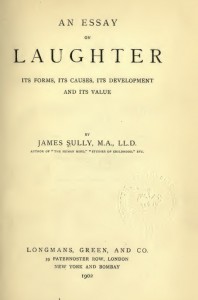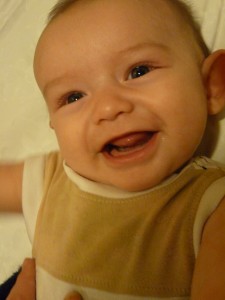 Dr Tiffany Watt-Smith is a British Academy Postdoctoral Fellow at the Centre for the History of the Emotions and the School of English and Drama, Queen Mary University of London. She is one of the BBC Radio 3 and AHRC New Generation Thinkers for 2014-15. In this post for the History of Emotions Blog, she asks what we can learn about science and emotion from the history of giggling babies….
Dr Tiffany Watt-Smith is a British Academy Postdoctoral Fellow at the Centre for the History of the Emotions and the School of English and Drama, Queen Mary University of London. She is one of the BBC Radio 3 and AHRC New Generation Thinkers for 2014-15. In this post for the History of Emotions Blog, she asks what we can learn about science and emotion from the history of giggling babies….
Babies are a tough crowd. You blow raspberries. You pull faces. And then your hat accidentally falls off, and you get a peel of raspy chuckles.
So imagine if trying to make babies laugh was your job.
‘It’s like being a stand-up comic’ says Dr Caspar Addyman, a psychologist investigating infant laughter at the BabyLab at Birkbeck University of London. Showing me around the basement laboratories, their walls painted grey to create a calm environment, Addyman admits he’s ‘full of glee to be doing this’. Here, Addyman and the parents who volunteer their babies to take part in his experiments, gurn, grin and play peekaboo. The giggles they elicit from their tiny experimental subjects are video recorded for later analysis. Addyman is only at the beginning of his research. He hopes to uncover the links between laughter and learning.
In our happiness-obsessed age, the idea that our emotions, and in particular, joy and delight, affect cognition is hardly new. But the importance of laughter in the early months of life has been little studied. Baby laughter was almost completely ignored by psychologists in the twentieth century. Even in the reams of books on the subject of games and play written by Swiss developmental guru Jean Piaget, the sheer exuberance of giggling babies is eclipsed by talk of curiosity and attention, frustration and rewards.
Just over a hundred years ago, however, baby laughter did arouse the interest of one man, James Sully (1842-1923). Sully was one of the pioneers of the study of mind as a scientific discipline in Britain, and in 1898 was responsible for setting up one of the UK’s first experimental psychological laboratories, at UCL, around the corner from the BabyLab in Bloomsbury. Though fascinated by topics as diverse as the pleasures of listening to music and optical illusions, it was his work in developmental psychology that brought Sully to the attention of the Victorian public. Studies of Childhood, a book Sully compiled from anecdotes sent in by parents, teachers and nursery workers, as well as observations of his own son, became a best-seller when it was published in 1895.
 In one of his subsequent books An Essay on Laughter, published in 1902, Sully expanded his discussion of the significance of laughter in the early years of life. In it, he wondered about the evolutionary purpose of contagious laughing in forging sympathetic bonds between parents and children. Sully also identified different baby laughs – from the ‘sudden glee’ in which ‘the arms flag wing-like or meet in the joyous clap and the whole body jumps’, to the ‘forced laugh’ some children develop in response to a situation they realize they are supposed to find funny.
In one of his subsequent books An Essay on Laughter, published in 1902, Sully expanded his discussion of the significance of laughter in the early years of life. In it, he wondered about the evolutionary purpose of contagious laughing in forging sympathetic bonds between parents and children. Sully also identified different baby laughs – from the ‘sudden glee’ in which ‘the arms flag wing-like or meet in the joyous clap and the whole body jumps’, to the ‘forced laugh’ some children develop in response to a situation they realize they are supposed to find funny.
Sully’s work built on insights by earlier nineteenth-century figures including Charles Darwin and the German psychologist, William Preyer, both of whom had observed their own children. He was also very influenced by the American Millicent Shinn, whose meticulous study of her niece Ruth was published in 1902 as A Year in the Life of a Child. Like them, Sully recognized that scientifically studying childrens’ emotions was a fraught process. Experimenters, who were often the parents themselves, were required to enter into a spirit of gleeful delight, whilst simultaneously recording the responses they witnessed. Darwin played peekaboo with his 110-day old son. Shinn observed her niece becoming excited by ‘the sight of the mother making faces’. Immersed in these playful worlds, the experimenters would be infected by the feelings they witnessed, and as Darwin warned in the Expression of the Emotions in Man and Animals, might imagine responses that weren’t really there.
Addyman’s experiments bypass this problem by splitting the process into two. While he and his fellow researchers play games with the babies, other psychologists are later recruited to analyse videos of the infants’ responses. What he does share with these Victorian experimenters, however, is that his own sense of fun is crucial to the success of the experiments. In the BabyLab, emotions aren’t simply objects of study. The experimenter’s own feelings must be carefully managed as part of the encounter.
Addyman’s comparison of himself to a stand-up is apt. Like a comic, Addyman produces fun on demand and deliberately creates a playful atmosphere. And like any performer, he has half an eye on his audience’s response. Not laughing? Addyman subtly adjusts his performance, or moves on. This is a far cry from the popular perception of scientific laboratories as cool and emotionless spaces. Though there are no scripts, such awareness of the delicate emotional ecosystem of the laboratory brings Addyman very close to the self-consciousness of the stand-up during a gig. Their performances also require them to not simply experience and enact feelings, but monitor their own performance and take their audience’s emotional temperature too.
Recent theorists of humour have turned to neuroscience and evolutionary psychology to try to find a rational basis for why we laugh. In doing so, they give the stamp of cultural authority to the scientist rather than the comedian.
It’s clear, however, that when it comes to trying to find out what tickles us, the lines of influence between science and stand-up run in both directions.
Read more about the Baby Laughter project here (and find out how to contribute to it).

